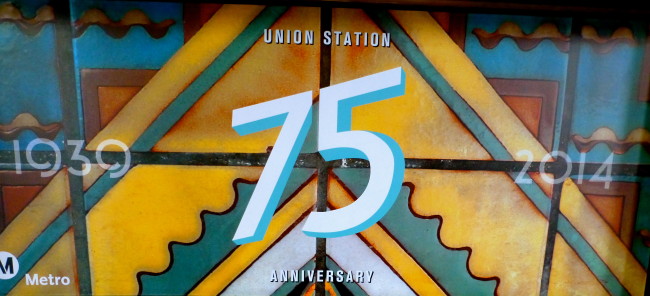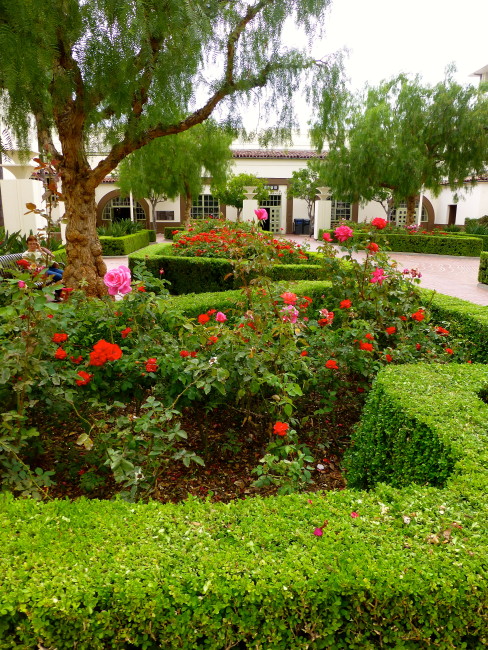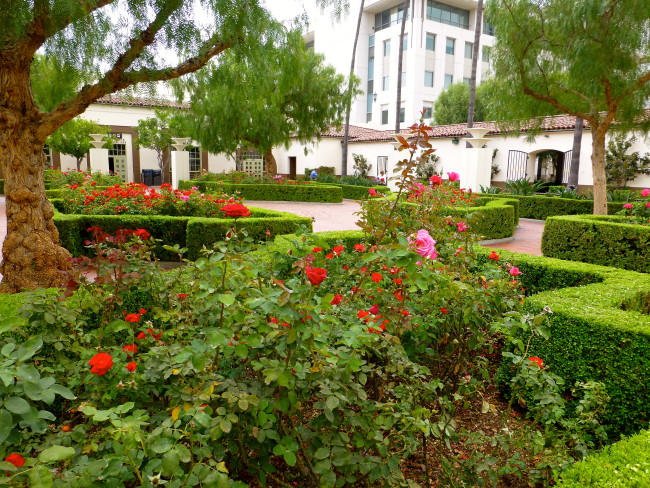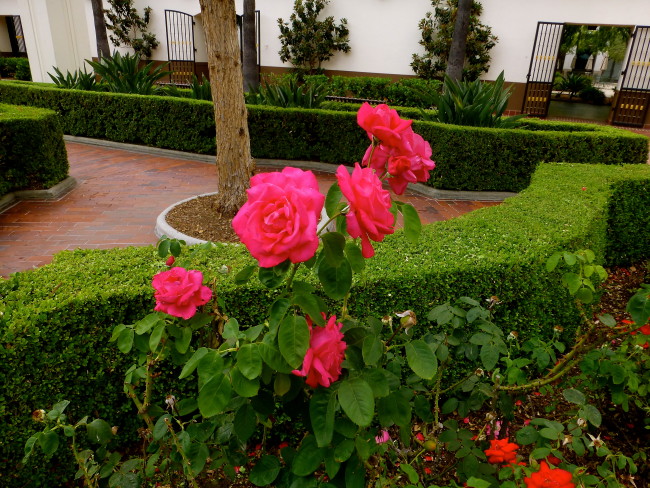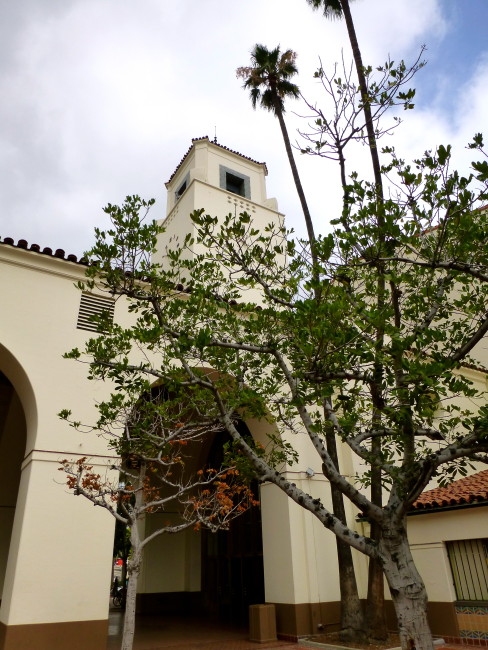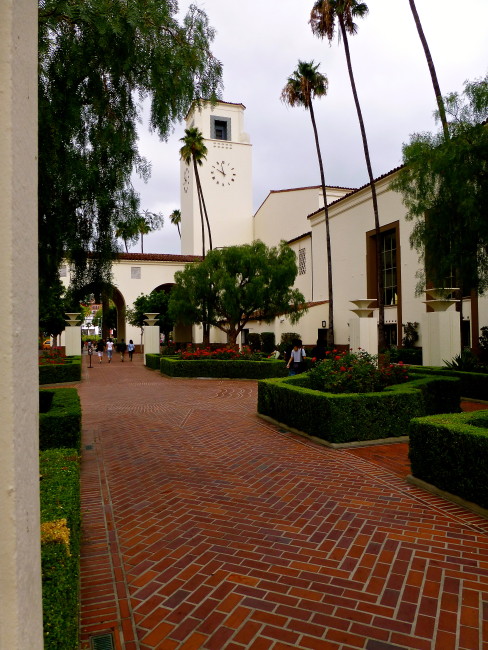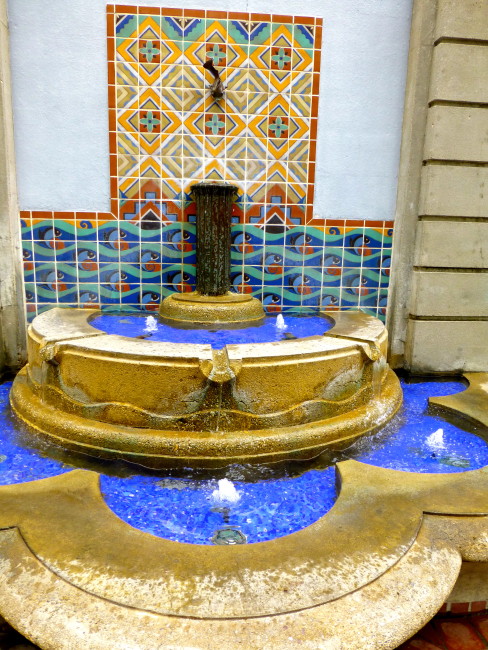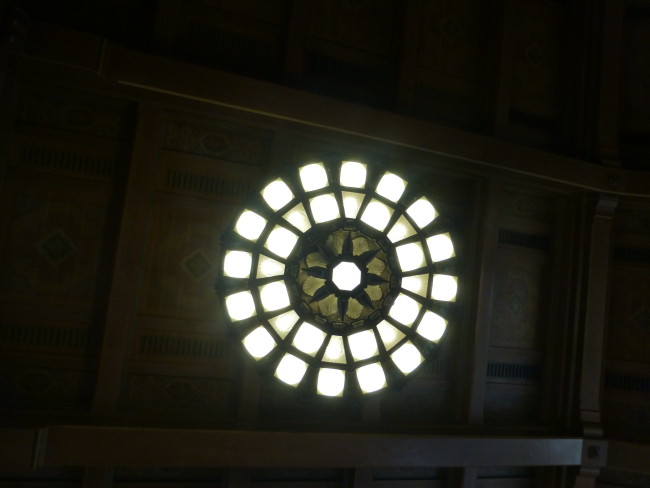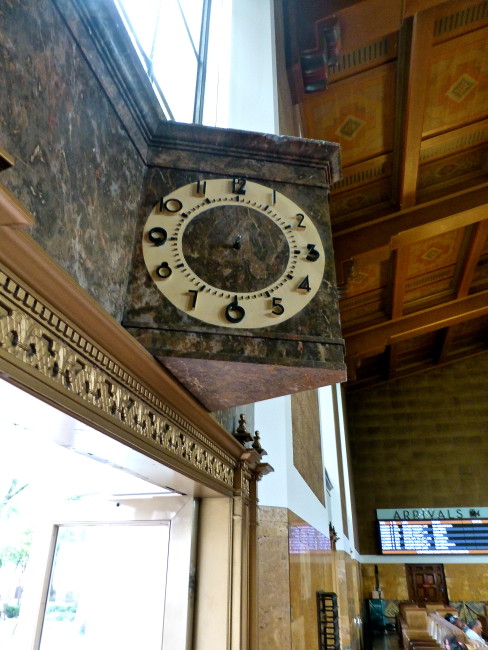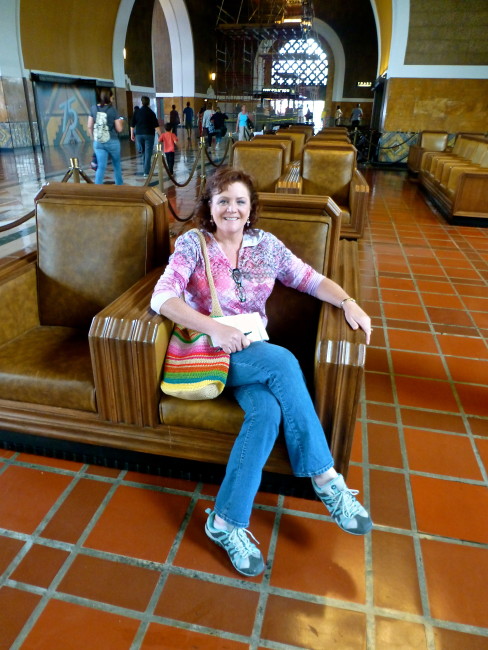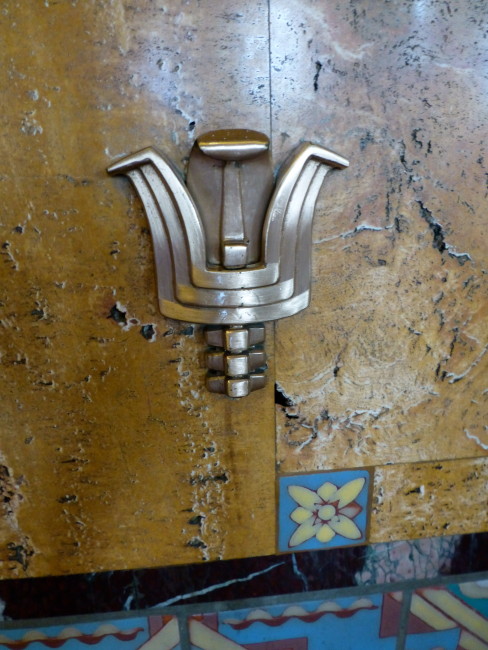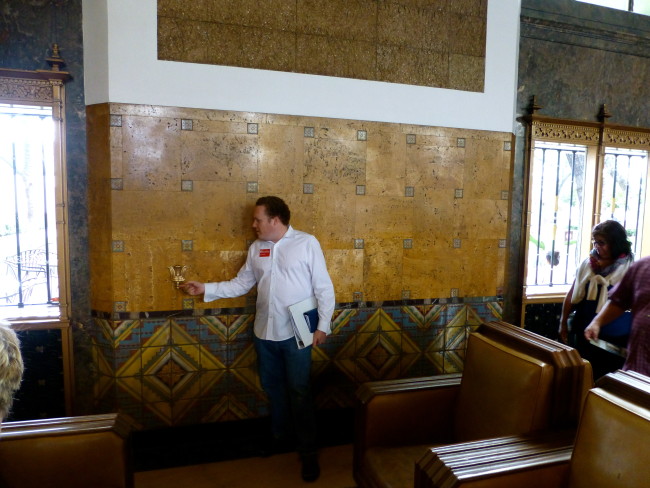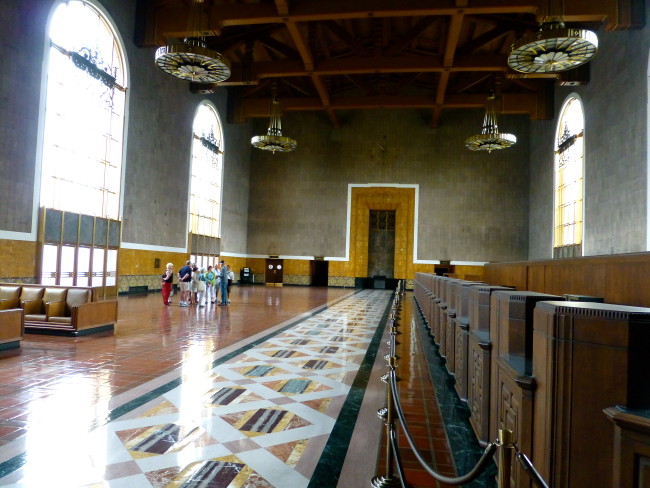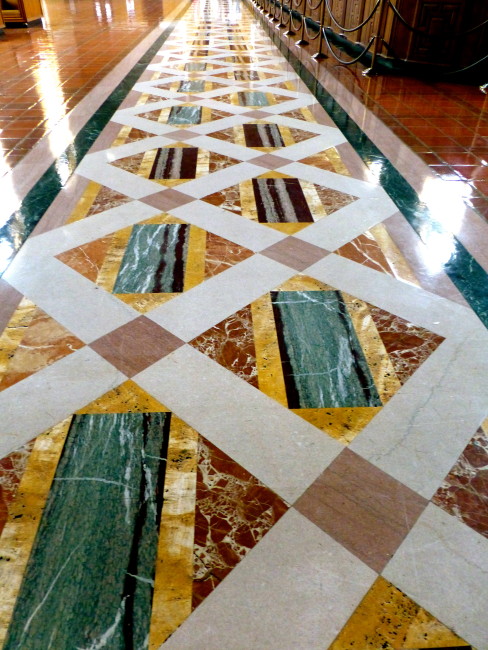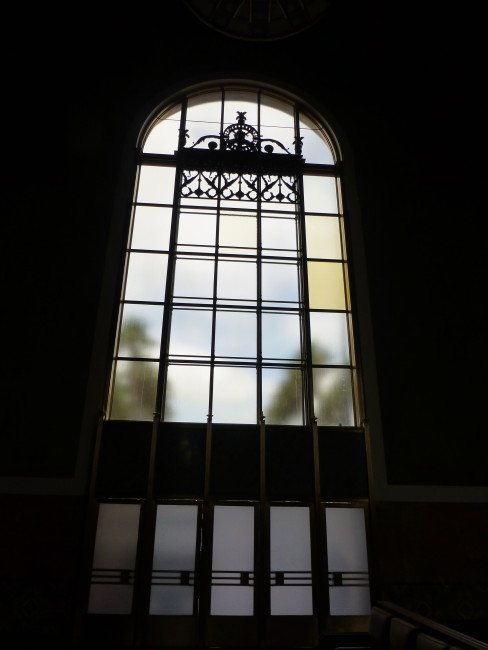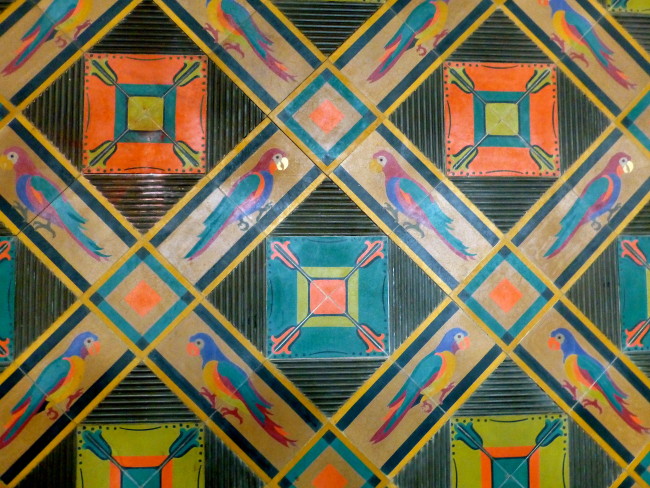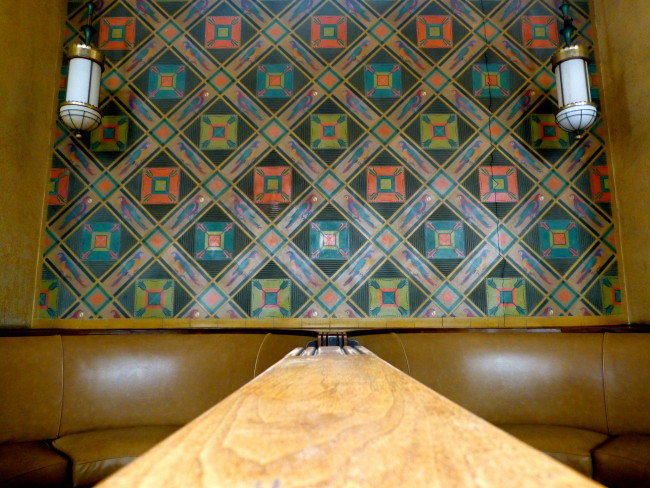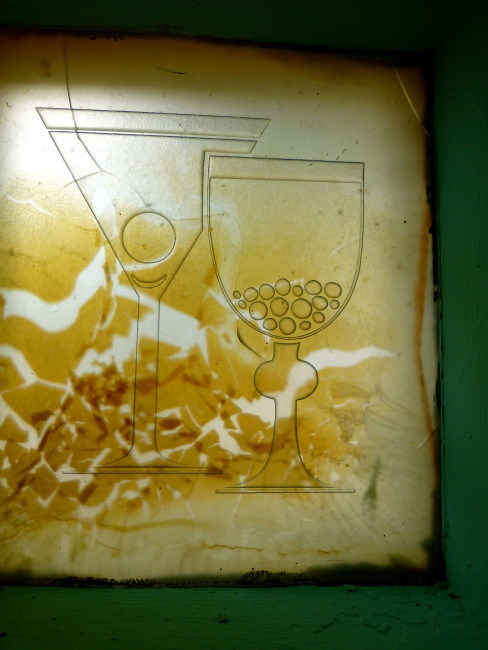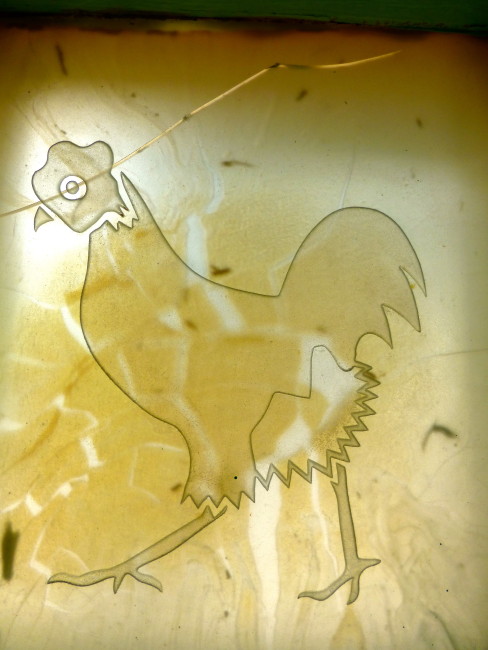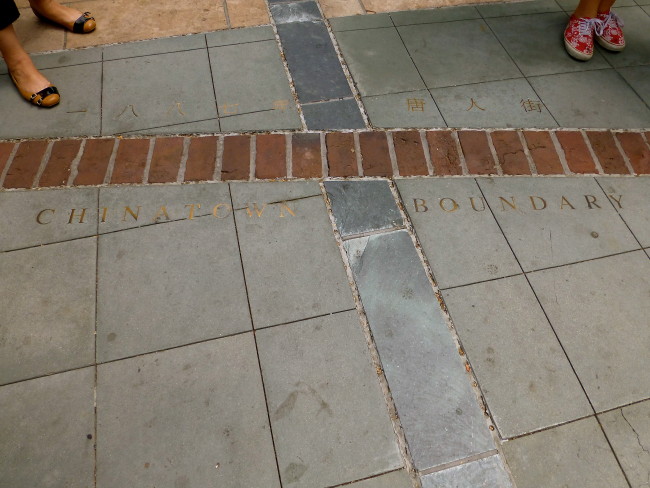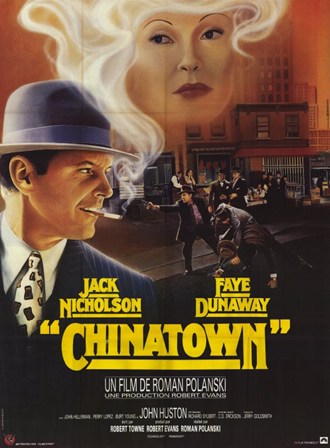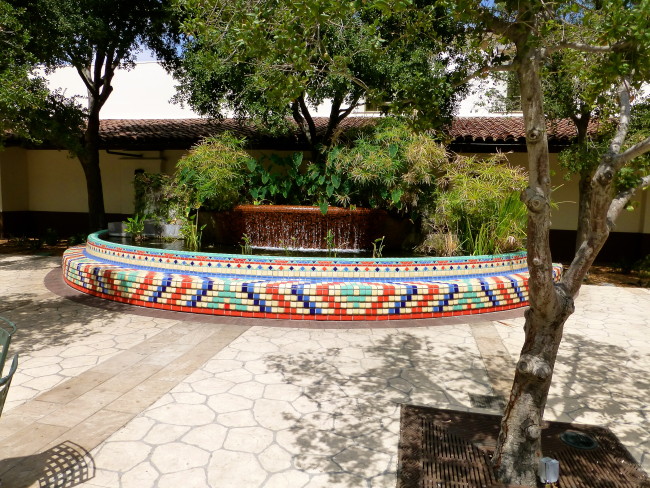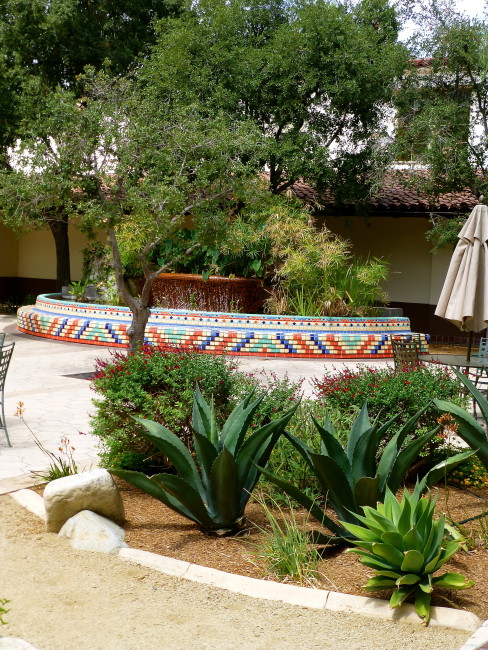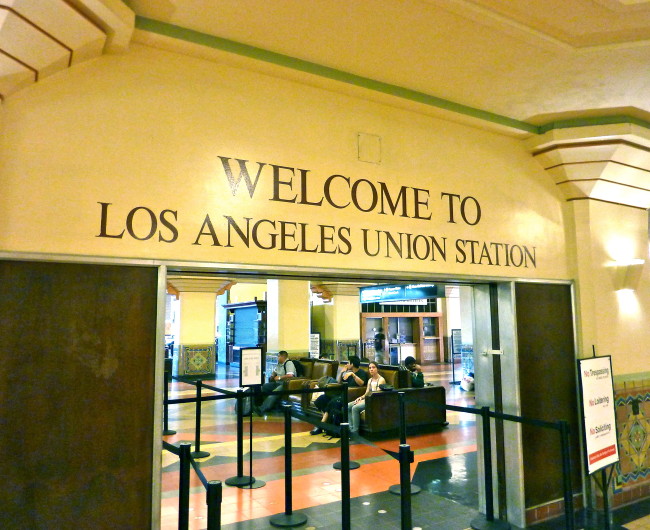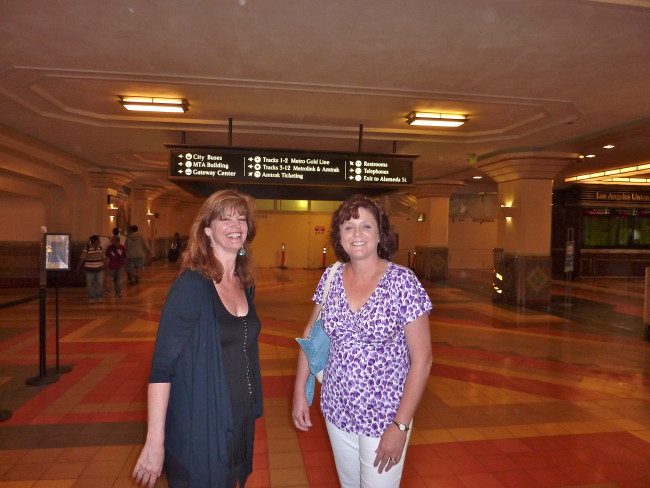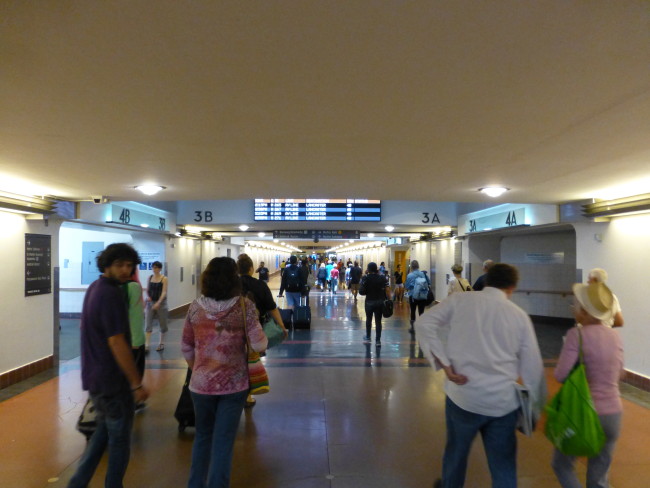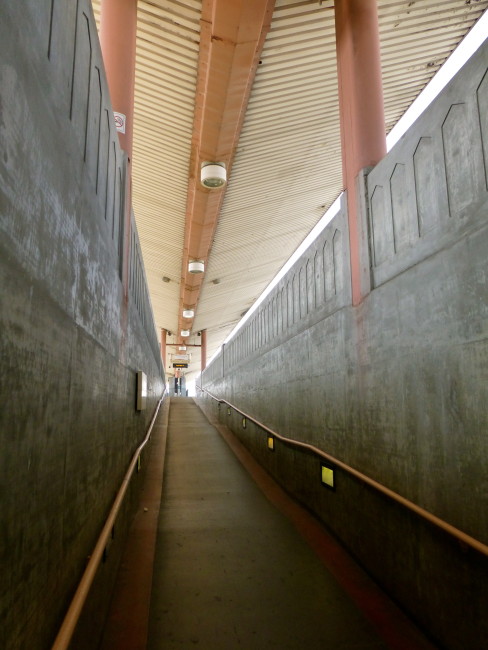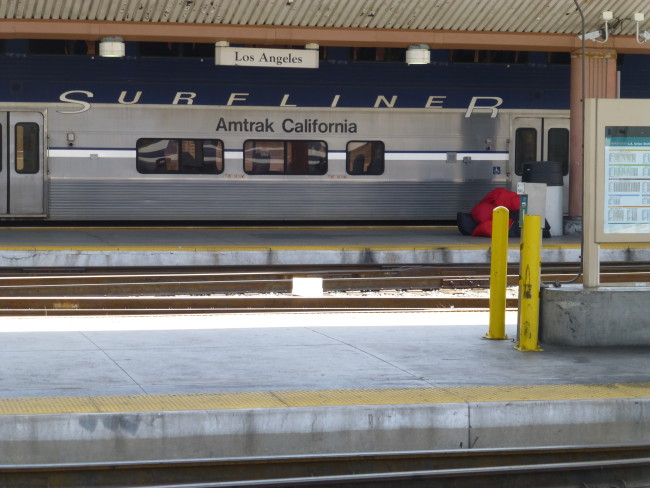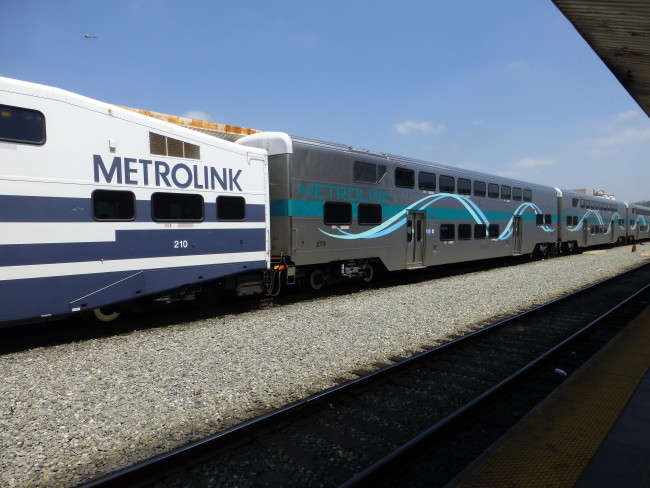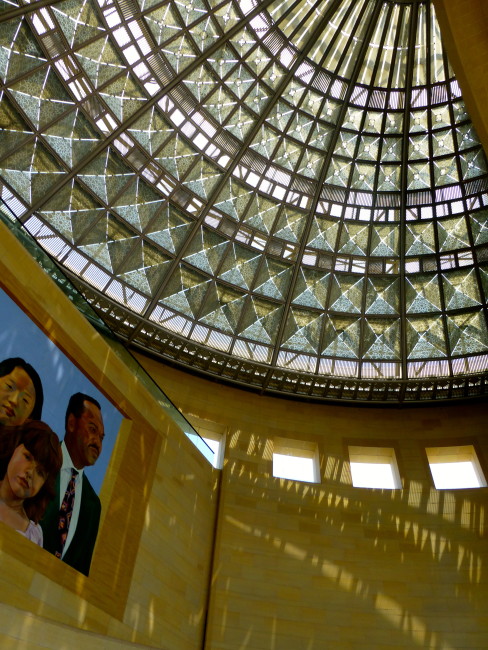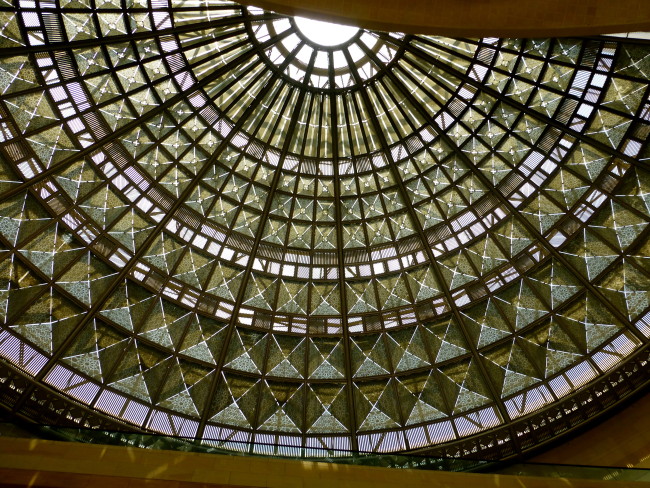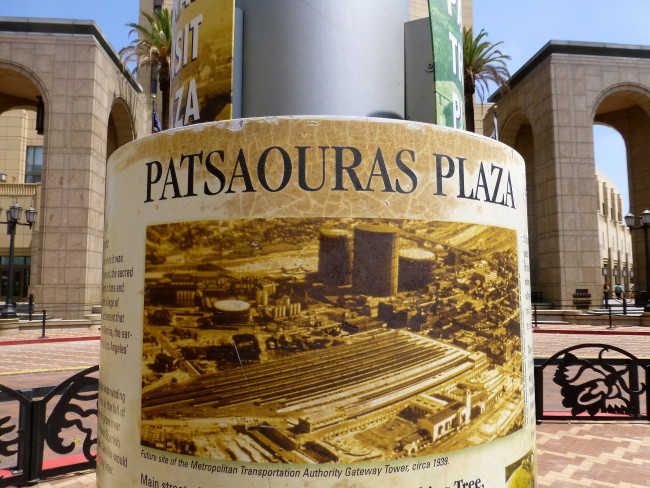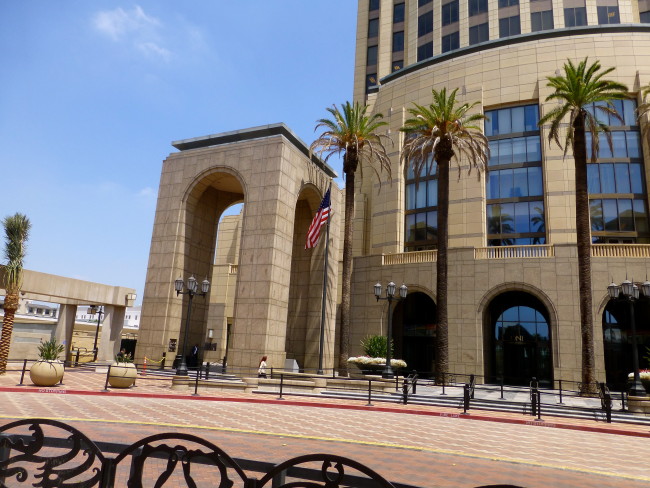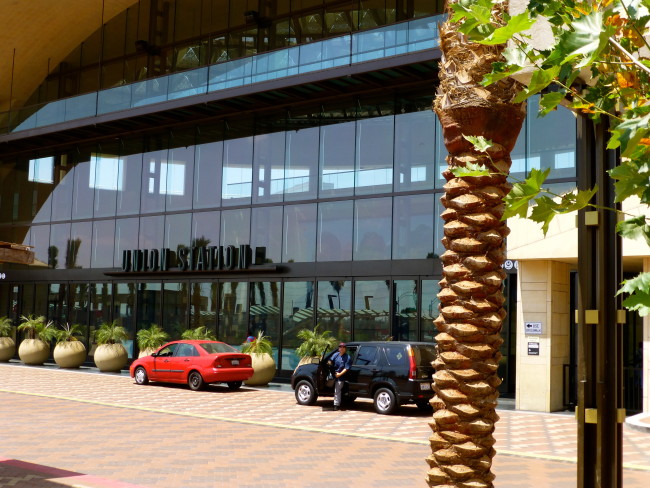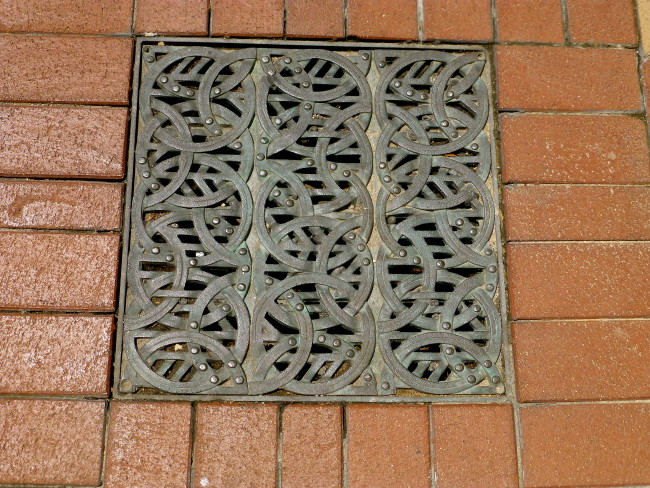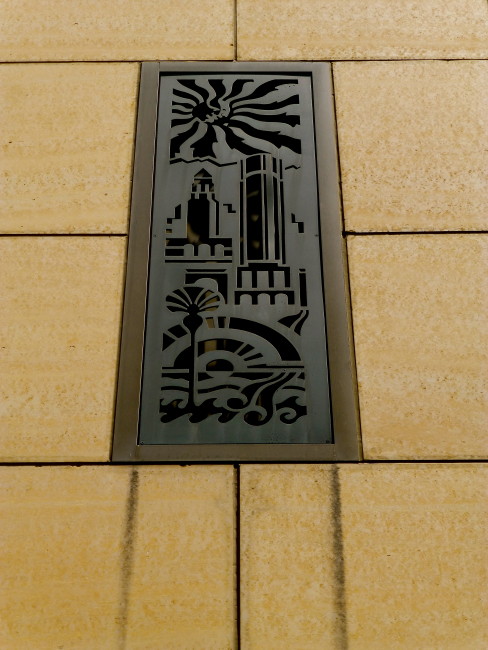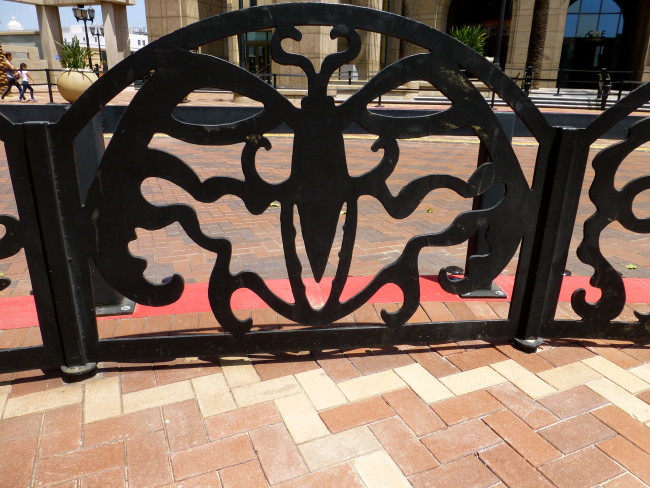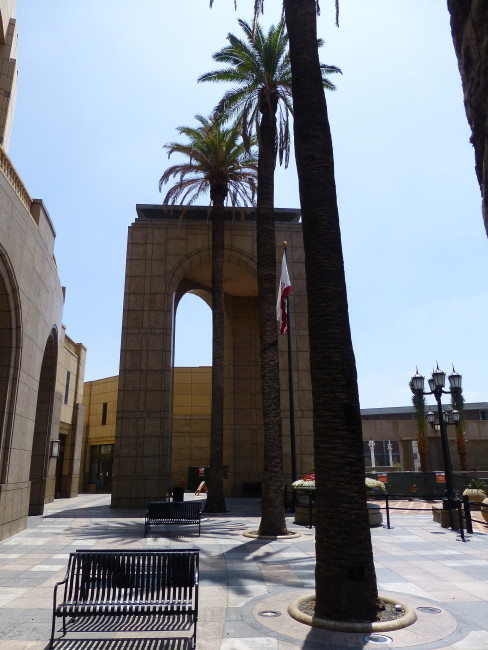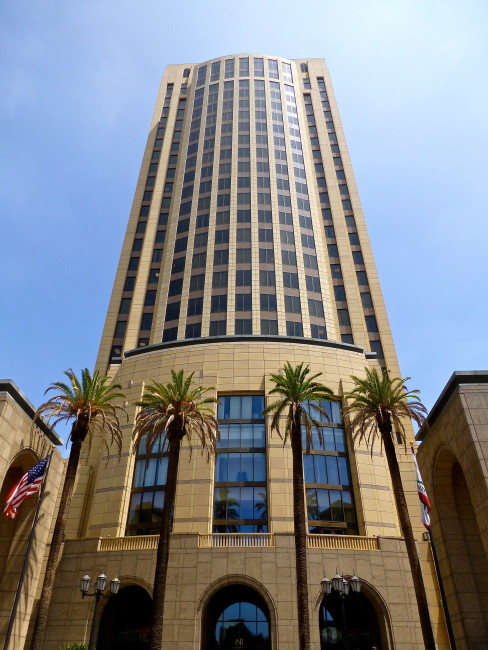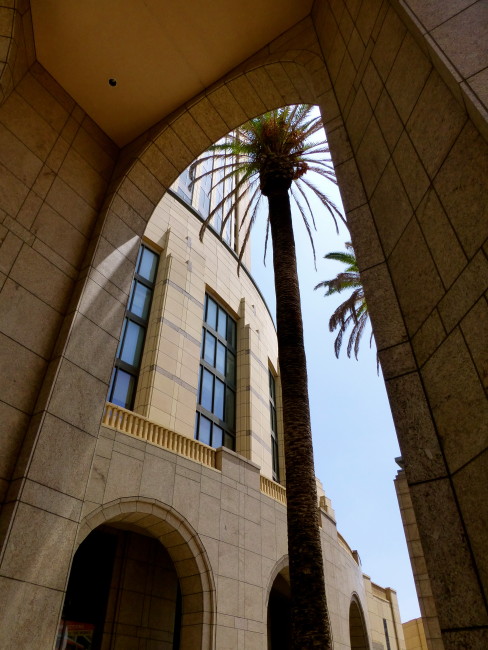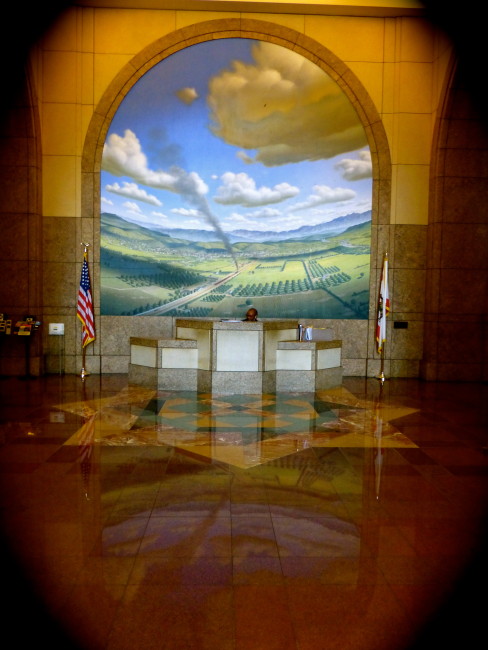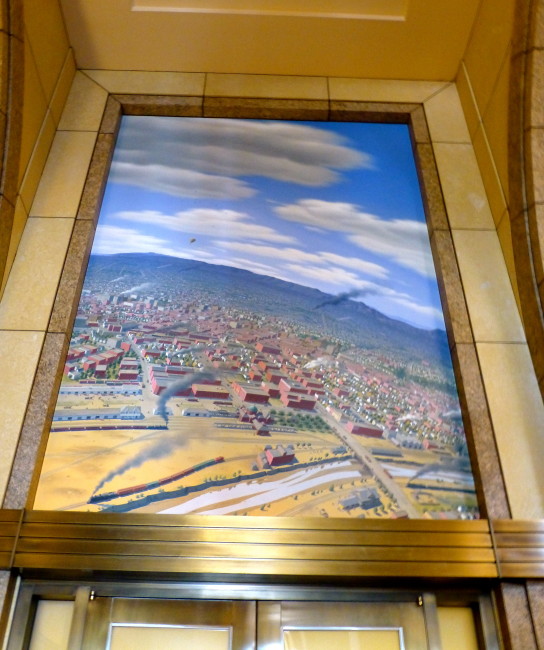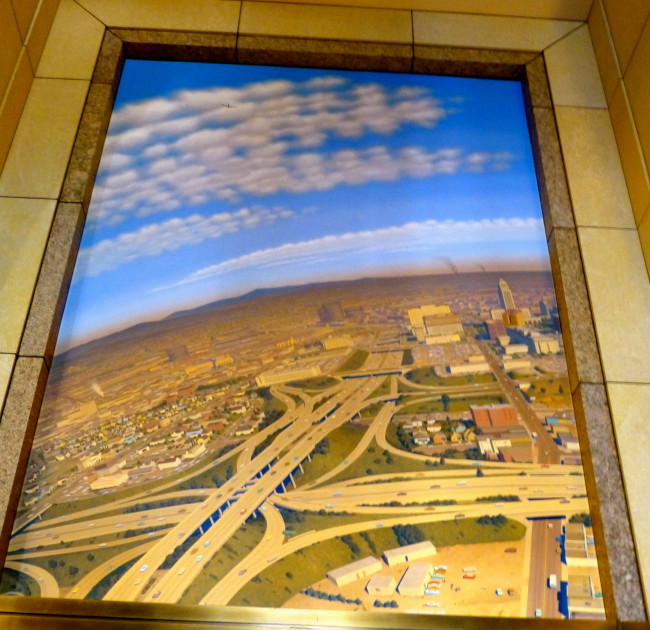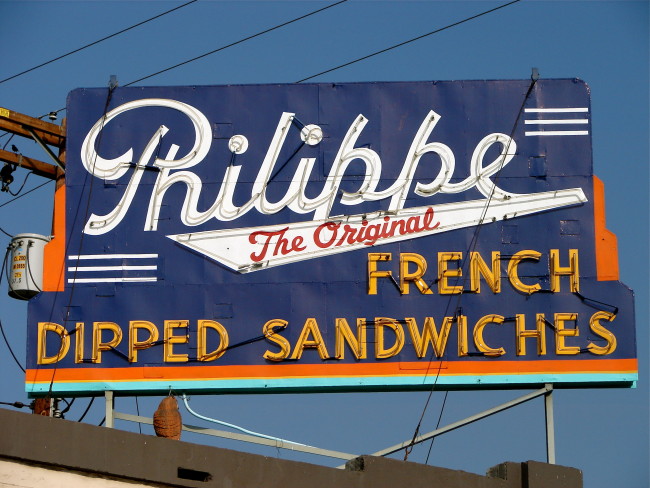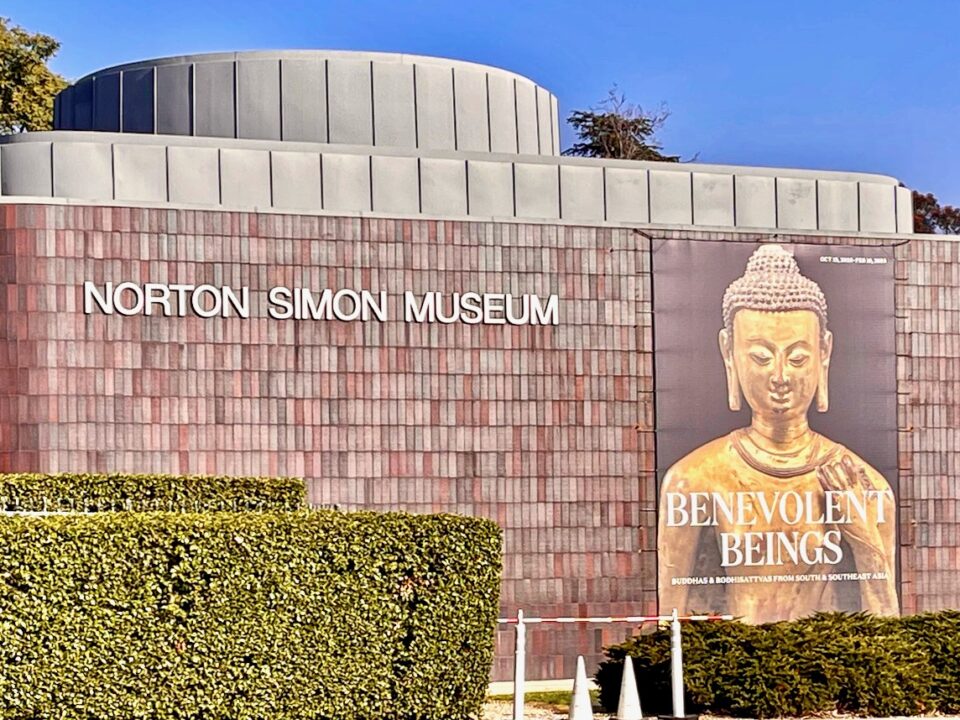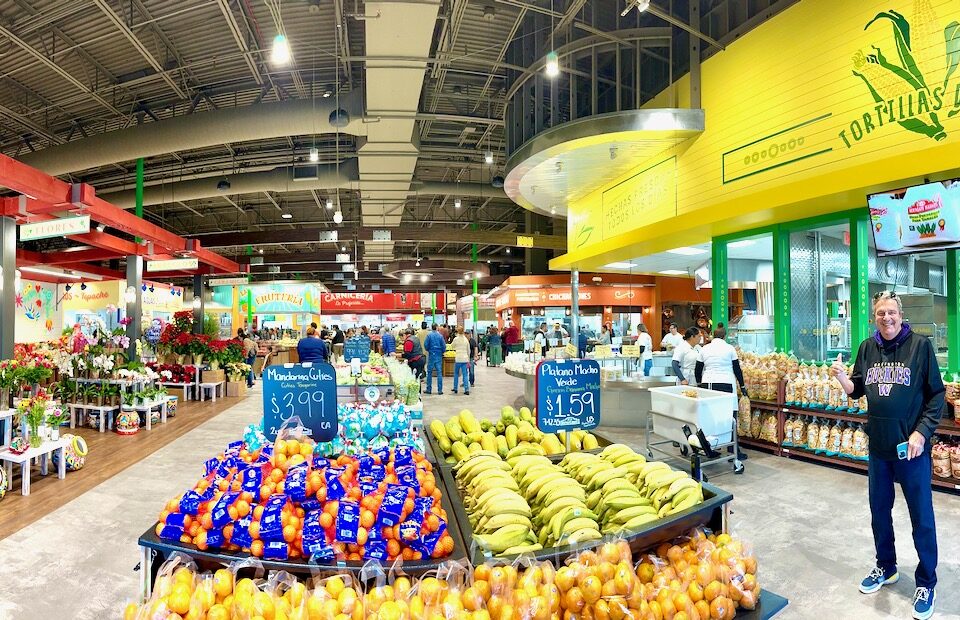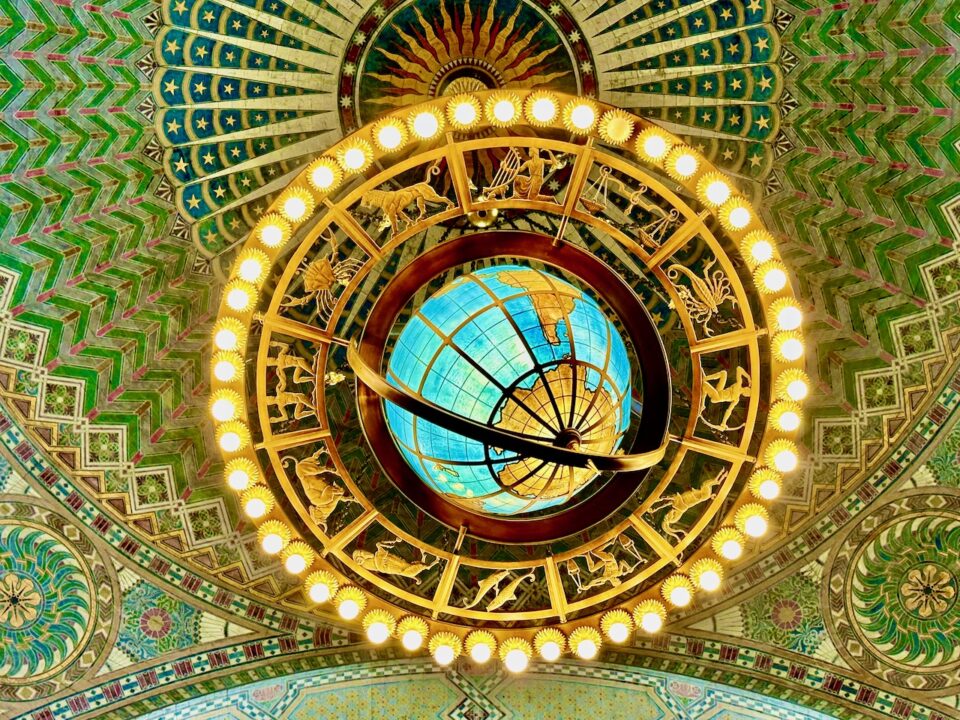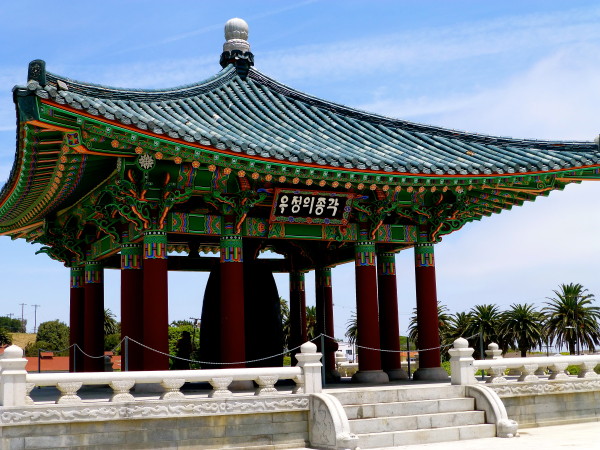
Korean Bell Of Friendship – San Pedro
January 2, 2015
Battleship USS IOWA Museum – San Pedro
May 12, 2015Getting On Track
Having already been on a couple of Los Angeles Conservancy tours in the past, Tracy and I headed downtown on a Saturday morning to check out an historic Los Angeles landmark that celebrated its 75th birthday in 2014. For this tour, we’d certainly need to keep our train of thought so as to not lose track of what was going on. That’s right, we were going to visit Union Station, and I will now stop these puns so you don’t start railing against me.
We met our guide, who first gave us a little history lesson about Union Station (here’s the CliffsNotes version).
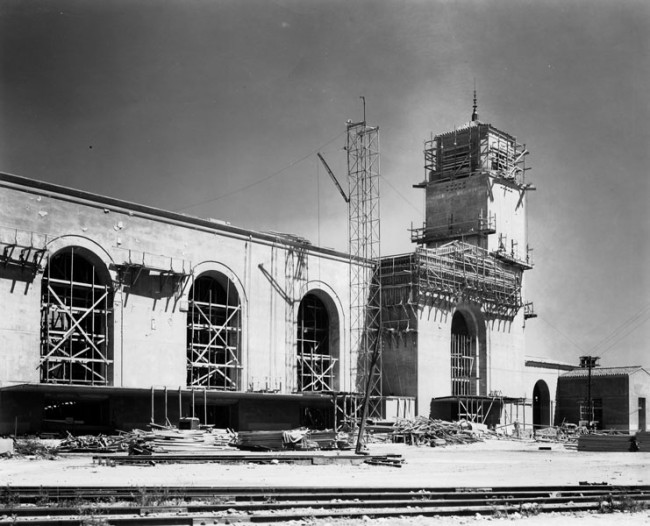 The station, now the largest railroad passenger terminal in the western United States, was built so it could consolidate three railroad lines…the Union Pacific, Southern Pacific and Atchison, Topeka and Santa Fe (where’s Judy Garland when you need her?).
The station, now the largest railroad passenger terminal in the western United States, was built so it could consolidate three railroad lines…the Union Pacific, Southern Pacific and Atchison, Topeka and Santa Fe (where’s Judy Garland when you need her?).
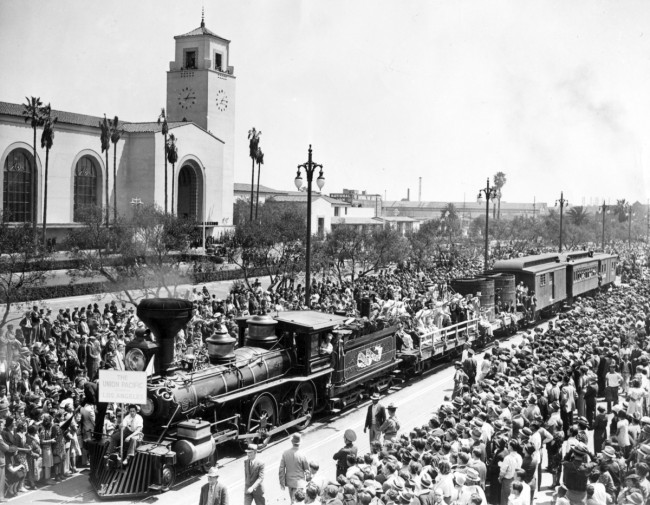 Architects for Union Station were Parkinson and Parkinson (father, John, and his son, Donald). Among their other accomplishments were Los Angeles City Hall (which I have also written about), the Colosseum (not the one in Rome) and Bullocks Wilshire department store. The Parkinsons wanted to build a train station that not only reflected L.A.’s Spanish heritage, but one that also incorporated some of the Moorish architecture which was the signature for the La Grande Station, which had been damaged in the Long Beach earthquake back in 1933. Upon completion, Union Station became the “last great railway station” built in the United States.
Architects for Union Station were Parkinson and Parkinson (father, John, and his son, Donald). Among their other accomplishments were Los Angeles City Hall (which I have also written about), the Colosseum (not the one in Rome) and Bullocks Wilshire department store. The Parkinsons wanted to build a train station that not only reflected L.A.’s Spanish heritage, but one that also incorporated some of the Moorish architecture which was the signature for the La Grande Station, which had been damaged in the Long Beach earthquake back in 1933. Upon completion, Union Station became the “last great railway station” built in the United States.
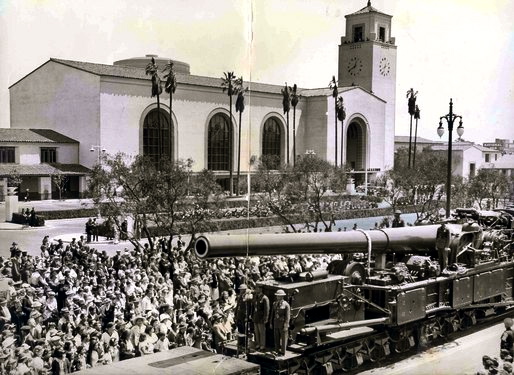 In May of 1939, Union Station was officially opened. They did things big back in the old days…more than 500,000 people showed up for the opening day parade (that was one person for every three that lived in the city of Los Angeles at the time…fairly amazing). As you can see by all these old photos, it was quite an event and attracted many stars from Hollywood (or at least one out of every three).
In May of 1939, Union Station was officially opened. They did things big back in the old days…more than 500,000 people showed up for the opening day parade (that was one person for every three that lived in the city of Los Angeles at the time…fairly amazing). As you can see by all these old photos, it was quite an event and attracted many stars from Hollywood (or at least one out of every three).
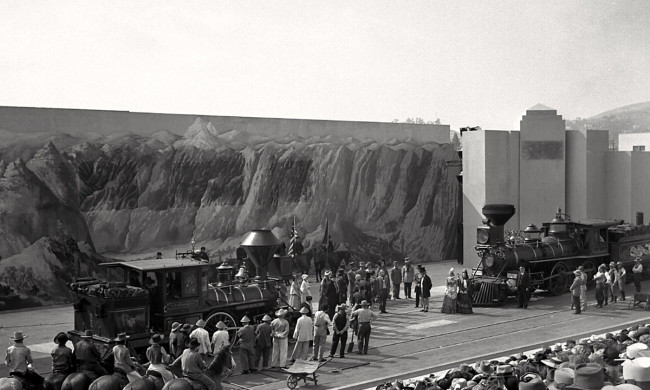 A temporary 6,000 seat amphitheatre was built for Cecil B. DeMille’s production of Romance Of The Rails (above), which depicted the history of Southern California and the importance of transportation. The festivities went on for three days. Our docent said that with DeMille at the helm, it was quite the theatrical production. The Southern Pacific’s No. 1 engine that dated from the late 1860s was a huge attraction as it rolled down Alameda.
A temporary 6,000 seat amphitheatre was built for Cecil B. DeMille’s production of Romance Of The Rails (above), which depicted the history of Southern California and the importance of transportation. The festivities went on for three days. Our docent said that with DeMille at the helm, it was quite the theatrical production. The Southern Pacific’s No. 1 engine that dated from the late 1860s was a huge attraction as it rolled down Alameda.
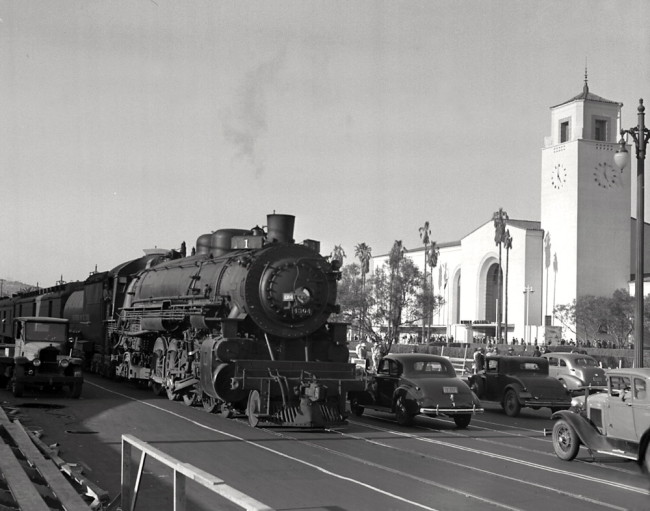 Our L.A. Conservancy tour met in The Entrance Lobby, and after our Union Station history lesson, it was time to take start walking. The tour coincidentally covered about 2 1/2 miles in 2 1/2 hours. I took a quick shot of this outdoor ceiling before we headed outside near the front of the building.
Our L.A. Conservancy tour met in The Entrance Lobby, and after our Union Station history lesson, it was time to take start walking. The tour coincidentally covered about 2 1/2 miles in 2 1/2 hours. I took a quick shot of this outdoor ceiling before we headed outside near the front of the building.
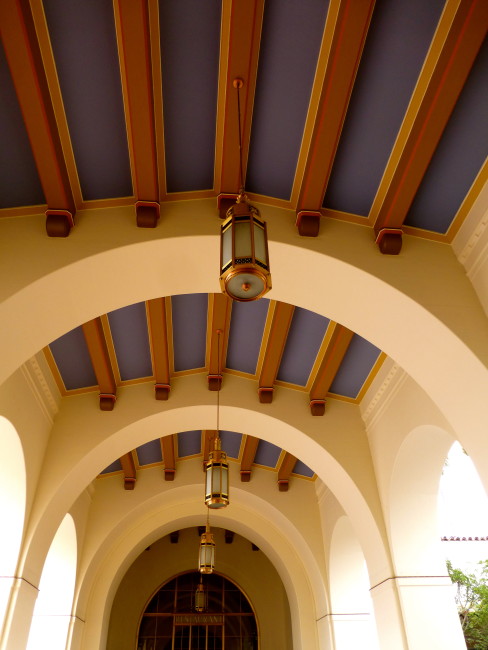 While standing outside, we were shown the bell tower and told that there is no bell in the bell tower. So much for ringing endorsements.
While standing outside, we were shown the bell tower and told that there is no bell in the bell tower. So much for ringing endorsements.
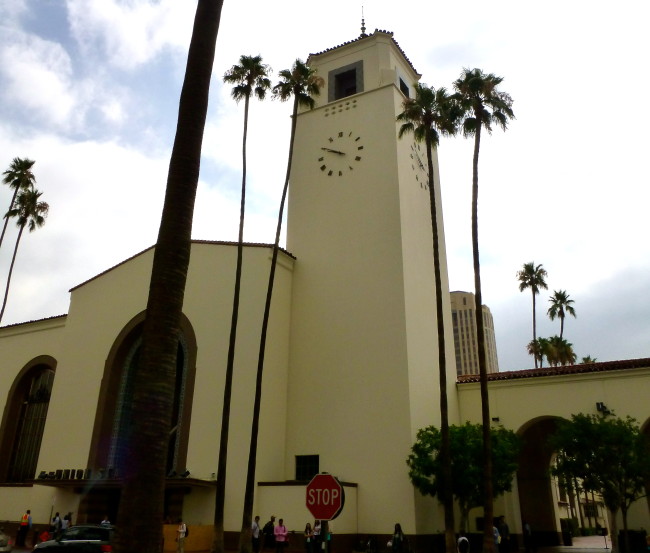 We learned Union Station was built in the Mission-style, because that was the least expensive model to follow in those days (it was the Depression, after all).
We learned Union Station was built in the Mission-style, because that was the least expensive model to follow in those days (it was the Depression, after all).
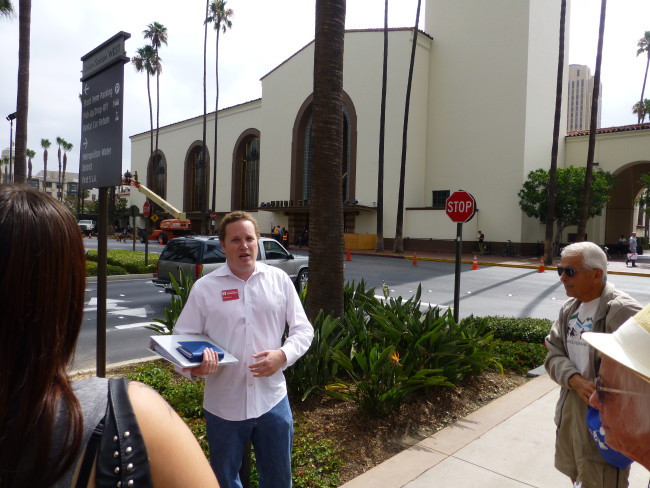 Technically, I believe the official architectural style for Union Station is known as “Pueblo Deco,” which incorporates Mission Revival, Moderne (Art-Deco) and Dutch Colonial Revival, but don’t hold me to that…I’d only had one cup of coffee by this time.
Technically, I believe the official architectural style for Union Station is known as “Pueblo Deco,” which incorporates Mission Revival, Moderne (Art-Deco) and Dutch Colonial Revival, but don’t hold me to that…I’d only had one cup of coffee by this time.
Next stop was an inner garden courtyard. It was here that we stopped to smell the roses (literally). It is one of two formal gardens you’ll find at Union Station.
Union Station has numerous outdoor areas that provide serenity while the masses are nearby inside the terminal.
There was also a lovely restored fountain in an outdoor waiting area, which I think was on the north side (I’ve been know to be “directionally impaired”).
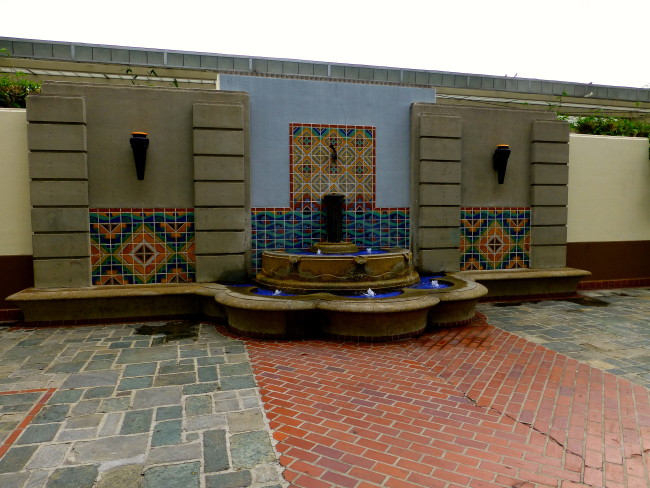 All the outdoor spaces were the work of a landscape architect, and in addition to fragrant roses you can feel serene in the midst of nearly 75,000 passengers (that’s how many people pass through here on an average day), sitting in the relative calm amongst palm, magnolia and orange trees.
All the outdoor spaces were the work of a landscape architect, and in addition to fragrant roses you can feel serene in the midst of nearly 75,000 passengers (that’s how many people pass through here on an average day), sitting in the relative calm amongst palm, magnolia and orange trees.
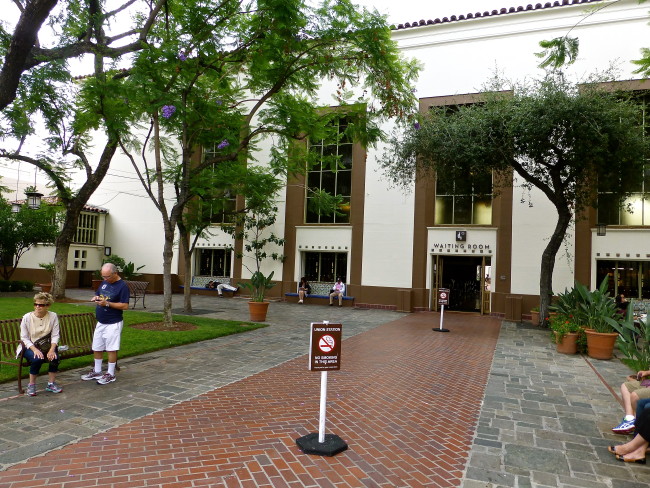 Now it was finally time to head inside from a side door into the restored Waiting Room where we finally got to check out the interior of the building.
Now it was finally time to head inside from a side door into the restored Waiting Room where we finally got to check out the interior of the building.
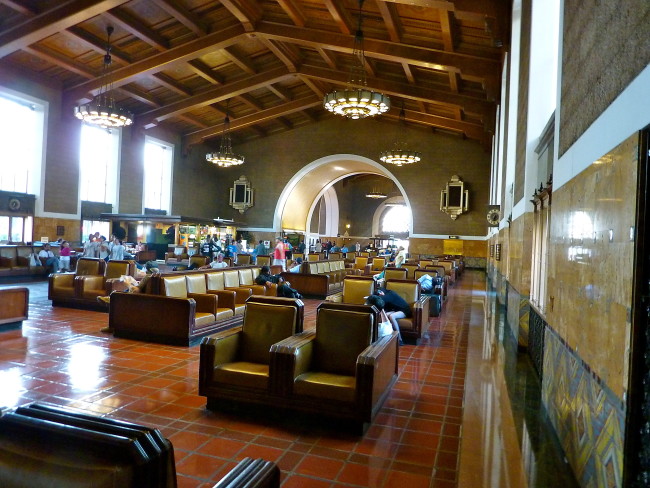 The first thing that stuck out on first glimpse was a gorgeous ceiling, which, as it turned out, was reinforced concrete painted to look like wood.
The first thing that stuck out on first glimpse was a gorgeous ceiling, which, as it turned out, was reinforced concrete painted to look like wood.
We hoped the chandeliers would stay in place, as they weigh 3,000 pounds apiece. Seemingly everywhere at Union Station there are a lot of clocks. I guess they don’t want you to miss the train.
The vinyl (they used to be leather), padded seats were comfortable, and we listened as our docent described the acoustical tiles on the wall and the blinds that can be lowered thanks to a crank-like device made out of brass.
The Waiting Room also contained a couple of dynamite speakers that would be great to play my music while I shoot hoops.
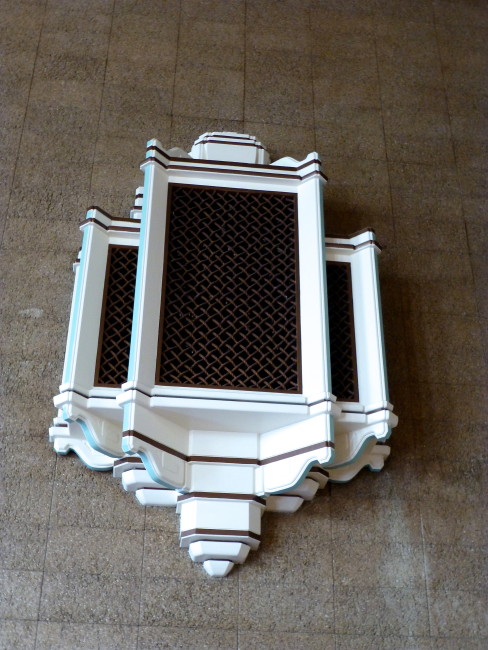 We were kind of disappointed in the “Arrival” and “Departure” signs as we are partial to the ones in Europe that “click, click, click” while displaying information (sometimes old-school is better, in my opinion).
We were kind of disappointed in the “Arrival” and “Departure” signs as we are partial to the ones in Europe that “click, click, click” while displaying information (sometimes old-school is better, in my opinion).
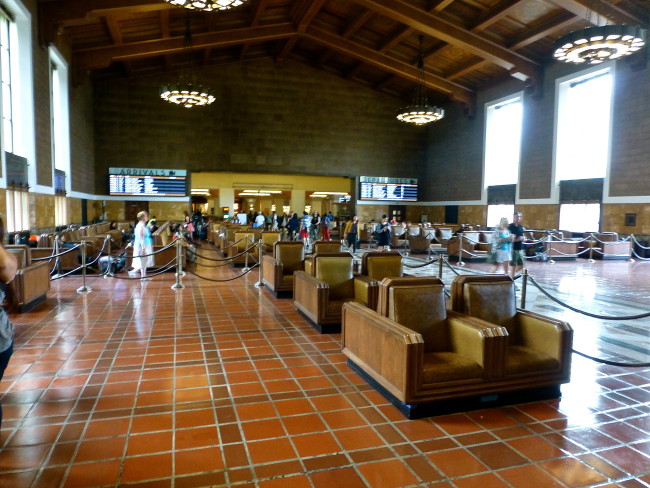 As walked to our next destination, we passed Traxx. The restaurant opened in the late 1990s, and I mentioned this could be fun place to go via the Metro Gold line for a “metro-politan” dining experience. I said, “Tracy, this would be a good place to “chew chew.” Fortunately our docent told us to move on before she left me.
As walked to our next destination, we passed Traxx. The restaurant opened in the late 1990s, and I mentioned this could be fun place to go via the Metro Gold line for a “metro-politan” dining experience. I said, “Tracy, this would be a good place to “chew chew.” Fortunately our docent told us to move on before she left me.
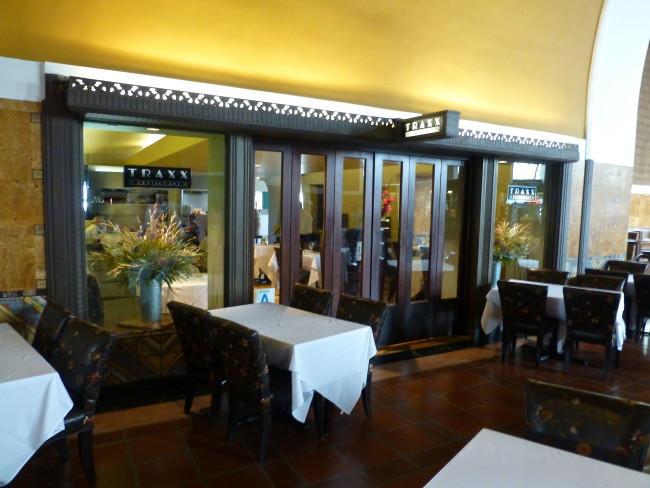 We walked past the Vestibule to the largest area in Union Station, the Ticket Concourse. I told Tracy that the entrance “was just a shell of what it used to be.” She started hanging out with other members of the tour after this.
We walked past the Vestibule to the largest area in Union Station, the Ticket Concourse. I told Tracy that the entrance “was just a shell of what it used to be.” She started hanging out with other members of the tour after this.
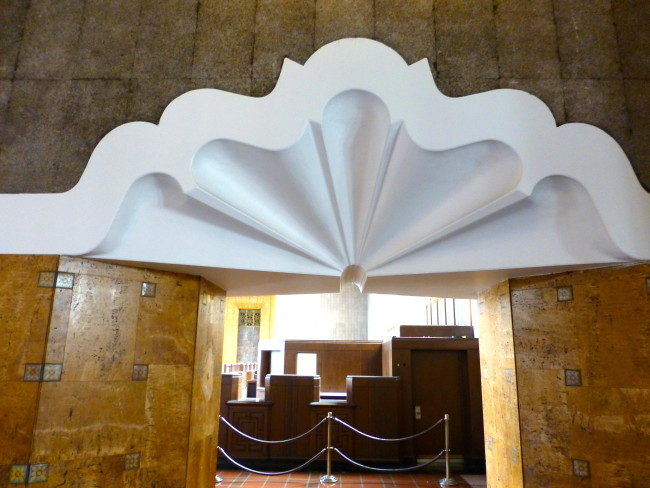 This section of Union Station has been featured in a number of films, including Batman, Catch Me If You Can and (of course) Union Station, which starred William Holden.
This section of Union Station has been featured in a number of films, including Batman, Catch Me If You Can and (of course) Union Station, which starred William Holden.
The Ticket Concourse, which is still used for special events, has a beautiful Spanish Tile floor that runs the length of the ticket counters, and arched windows that stretch three stories high.
Back in the day this was an area that contained women’s dressings rooms, a men’s restroom where you could shower and other nice amenities for the traveler.
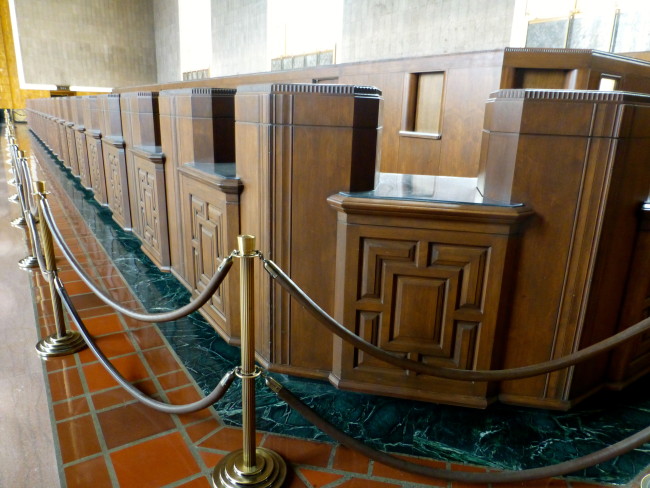 The Ticket concourse also has a beautiful ceiling complete with the “killer” chandeliers.
The Ticket concourse also has a beautiful ceiling complete with the “killer” chandeliers.
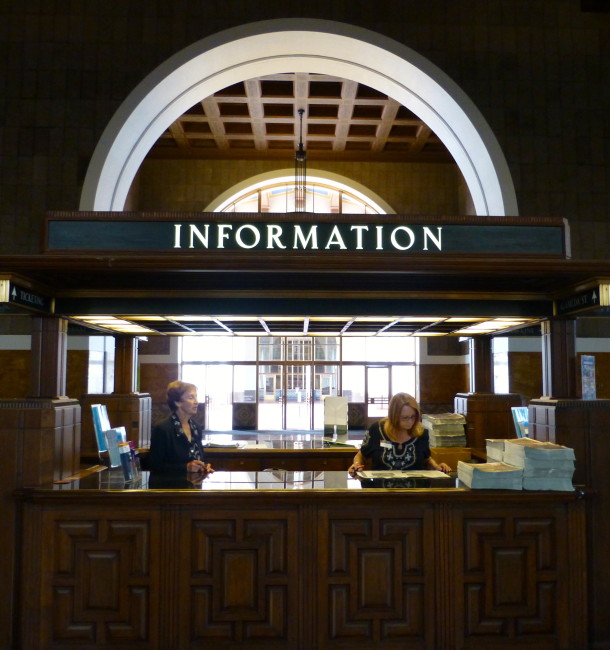 We walked past the the Information booth and headed toward a famed dining area where well-heeled passengers used to hang out.
We walked past the the Information booth and headed toward a famed dining area where well-heeled passengers used to hang out.
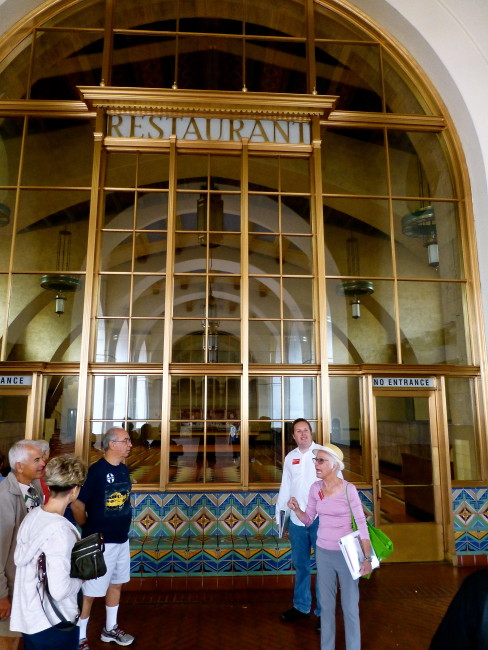 The Fred Harvey restaurants were once a part of an upscale chain of dining establishments. Speaking of Judy Garland, these restaurants were made even more famous by the 1946 movie, The Harvey Girls, starring the late, great singer/actress. Yep, that’s the movie that won Best Song for…On the Atchison, Topeka and the Santa Fe. It’s just tidbits of info like that should make you want to come back to this website every so often.
The Fred Harvey restaurants were once a part of an upscale chain of dining establishments. Speaking of Judy Garland, these restaurants were made even more famous by the 1946 movie, The Harvey Girls, starring the late, great singer/actress. Yep, that’s the movie that won Best Song for…On the Atchison, Topeka and the Santa Fe. It’s just tidbits of info like that should make you want to come back to this website every so often.
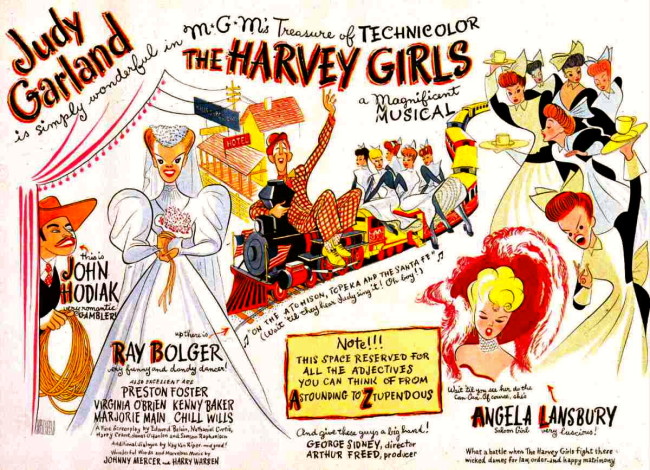 Fred Harvey was an immigrant from England who eventually opened what would be the “first American chain” of restaurants. He put out ads looking for “single, white, young women, 18 to 30 years of age, of good character, attractive and intelligent.” They had to wear make-up, learn proper etiquette and wear black and white nun-like uniforms. Too bad he didn’t have the foresight to hire both black and white Harvey Girls.
Fred Harvey was an immigrant from England who eventually opened what would be the “first American chain” of restaurants. He put out ads looking for “single, white, young women, 18 to 30 years of age, of good character, attractive and intelligent.” They had to wear make-up, learn proper etiquette and wear black and white nun-like uniforms. Too bad he didn’t have the foresight to hire both black and white Harvey Girls.
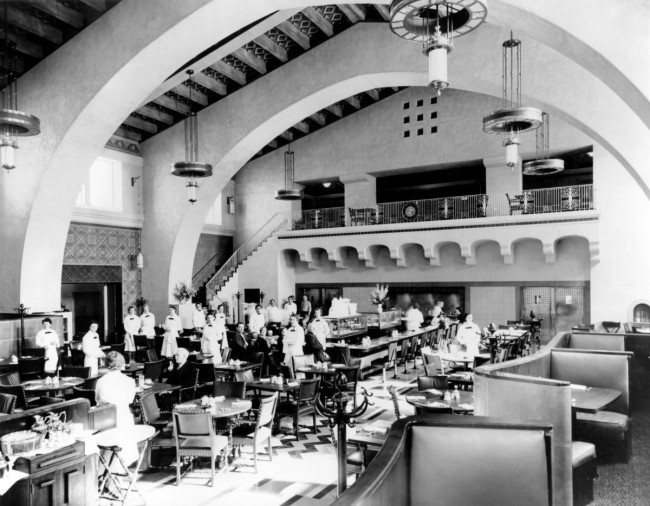 We learned some other interesting trivia from our docent, such as if a Harvey Girl got married or indulged in “inappropriate behavior,” she was history as a Harvey Girl. According to The Camp Fire Chronicles (True Stories Of The American West) website, “...there were over 100,000 Harvey Girls. While they were not allowed to fraternize with the customers, more than 20,000 Harvey Girls are believed to have married a regular customer.”
We learned some other interesting trivia from our docent, such as if a Harvey Girl got married or indulged in “inappropriate behavior,” she was history as a Harvey Girl. According to The Camp Fire Chronicles (True Stories Of The American West) website, “...there were over 100,000 Harvey Girls. While they were not allowed to fraternize with the customers, more than 20,000 Harvey Girls are believed to have married a regular customer.”
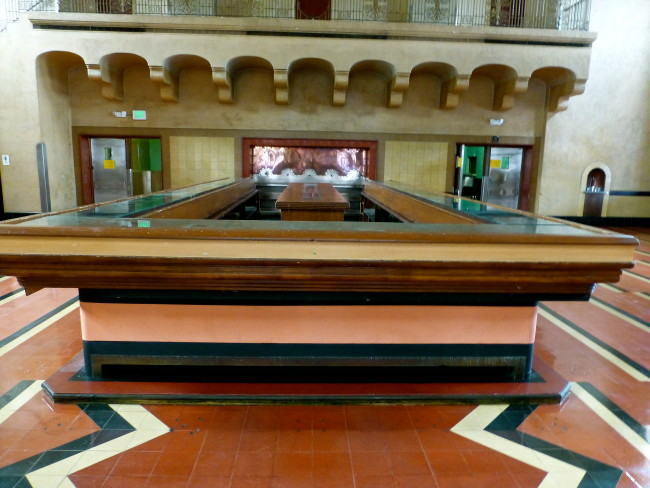 This Harvey House was designed by Southwestern architect, Mary Colter.
This Harvey House was designed by Southwestern architect, Mary Colter.
We meandered through the restaurant area, checking out the booths and concrete Parrot tile, the bar area…a beautiful staircase…
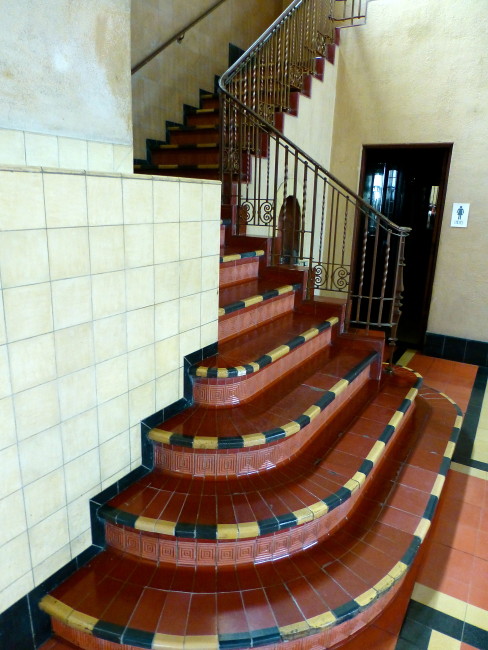 …and through the bowels of the restaurant to the old kitchen where there were still a couple of original windows…
…and through the bowels of the restaurant to the old kitchen where there were still a couple of original windows…
…and an old sink to where they could wash their hands.
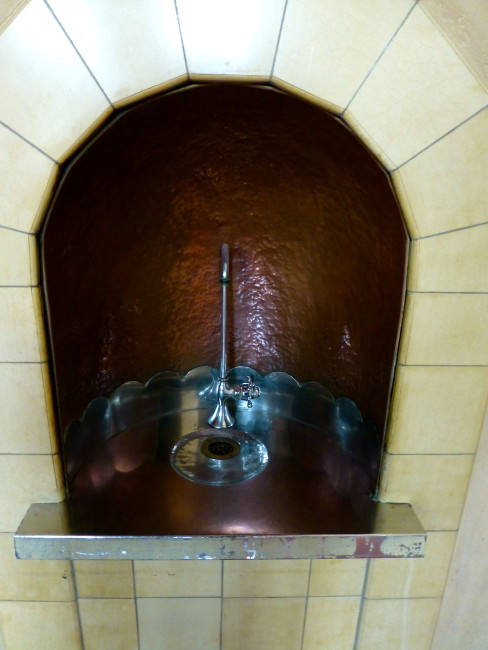 This Harvey House restaurant closed in 1967. It’s rented out for special events, and rumors circulate that a Gastropub might go in here. Then we hit another outdoor hallway on the way to our next stop on the tour.
This Harvey House restaurant closed in 1967. It’s rented out for special events, and rumors circulate that a Gastropub might go in here. Then we hit another outdoor hallway on the way to our next stop on the tour.
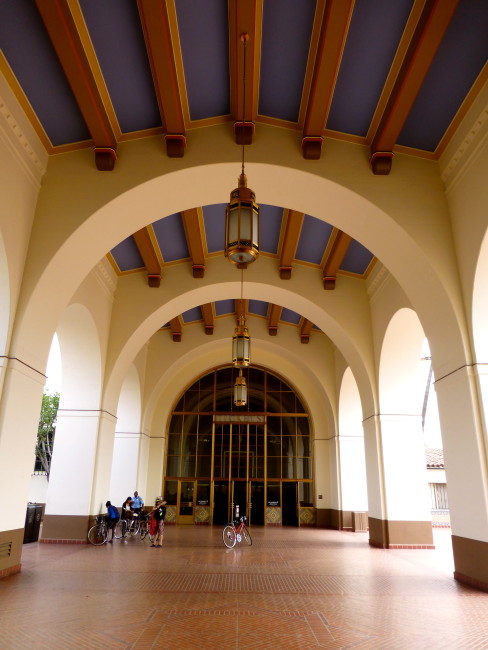 Back out in the sunlight we visited the other garden (I believe the South Garden if I was correct about the North one..otherwise it’s the other way around), where we stood at the boundary of Chinatown (no Jack Nicholson sighting, however).
Back out in the sunlight we visited the other garden (I believe the South Garden if I was correct about the North one..otherwise it’s the other way around), where we stood at the boundary of Chinatown (no Jack Nicholson sighting, however).
This is also the area where one can get married, or in train lingo, “hitched.”
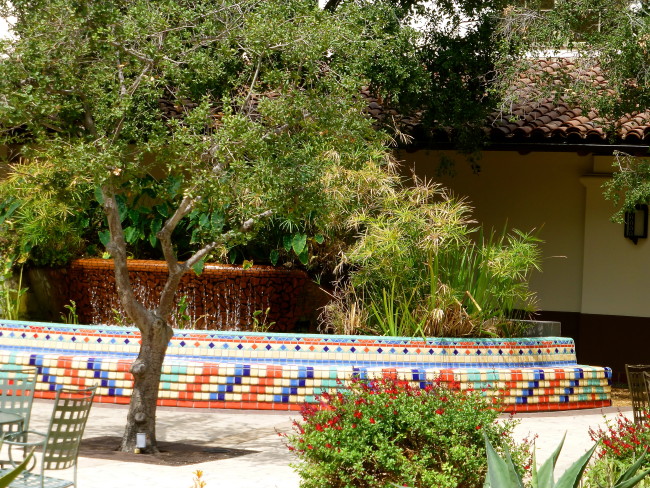 There was no comment when I asked if you could come back if your marriage “goes off the rails.”
There was no comment when I asked if you could come back if your marriage “goes off the rails.”
We headed back through the terminal…
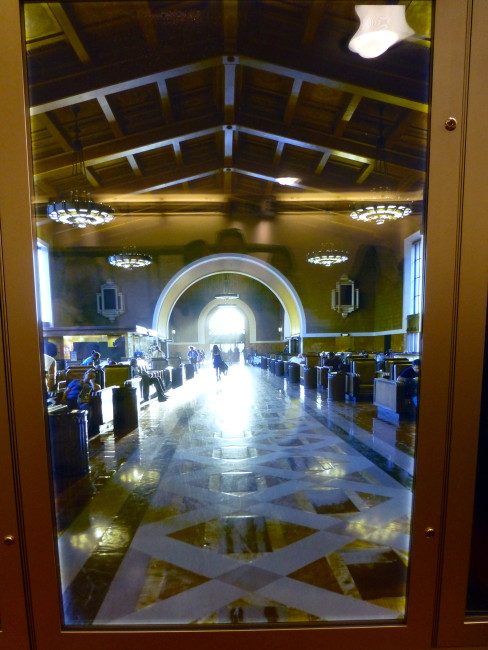 …to the arrival and departure area.
…to the arrival and departure area.
The above photos were taken when we and four friends used Gold and Red Line Metro service to get from Pasadena to Hollywood for dinner one evening (see Musso & Frank Grill in Tom’s Dining Out...it’s quite a story).
Down the tunnel we walked toward what this station is really all about…the trains. Stepping outside, we were told about future expansion plans in store for Union Station. I will probably be dead long before those plans are ever completed.
Our next stop was the East Portal, which was added in the mid 90s. City Of Dreams/River Of History is an 80-foot-long mural that was done by Richard Wyatt, a Los Angeles artist.
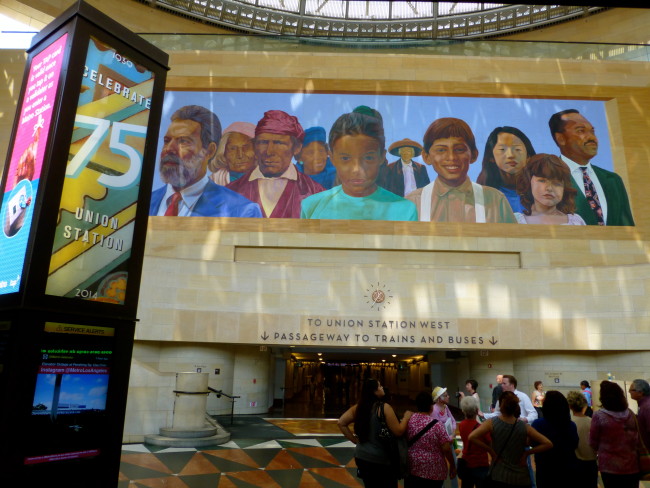 It was installed in 1996 and has been restored in recent years. There is also a beautiful steel and glass domed ceiling here.
It was installed in 1996 and has been restored in recent years. There is also a beautiful steel and glass domed ceiling here.
Stepping outside, we found ourselves at Patsaouras Transit Plaza…
…which is not only a photogenic area but functional because this is where you can catch a bus after arriving or catch a FlyAway bus to LAX.
…and the gates.
Our next (and last) destination was the 28 story Metropolitan Transit Building, which is memorable due to its gorgeous murals.
There were four murals by James Doolin that depict Los Angeles during various eras. The 1870s…
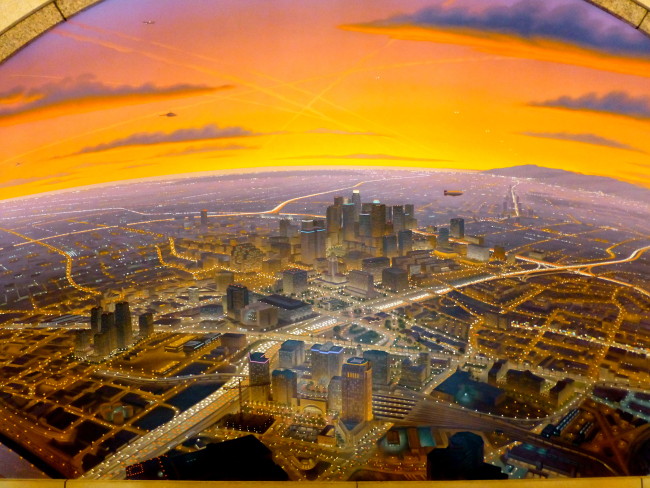 There were also some nice views back over the train canopies toward the City Of Angels.
There were also some nice views back over the train canopies toward the City Of Angels.
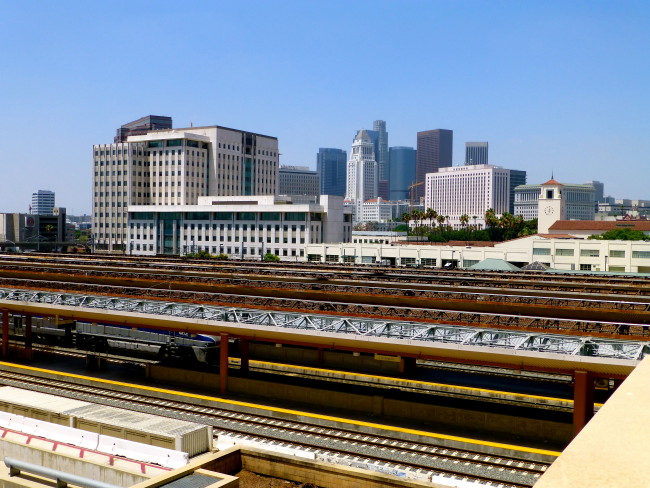 The tour was now officially complete. The L.A. Conservancy tours have all been good, but this was the best one up to now.
The tour was now officially complete. The L.A. Conservancy tours have all been good, but this was the best one up to now.
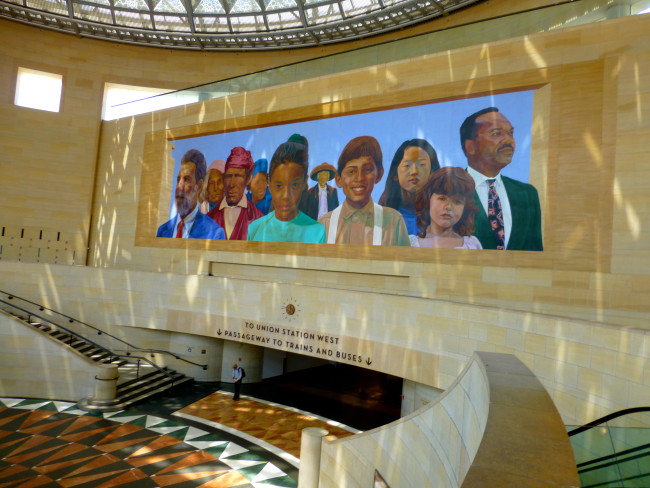 We walked back to Union Station just to walk around a little bit more.
We walked back to Union Station just to walk around a little bit more.
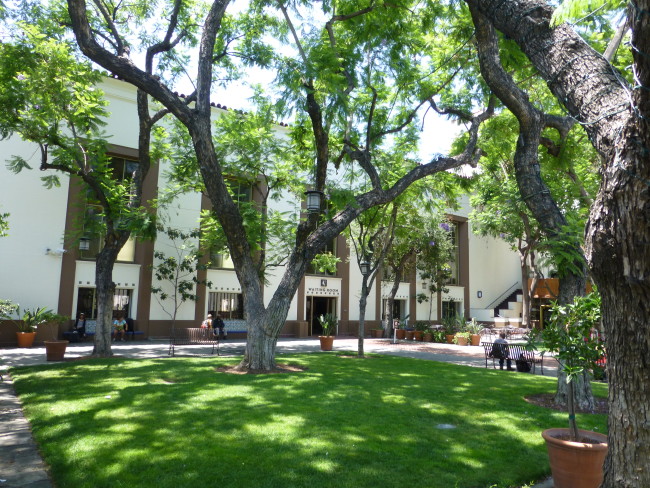 We came upon a plaque entitled “Unfinished Journeys.”
We came upon a plaque entitled “Unfinished Journeys.”
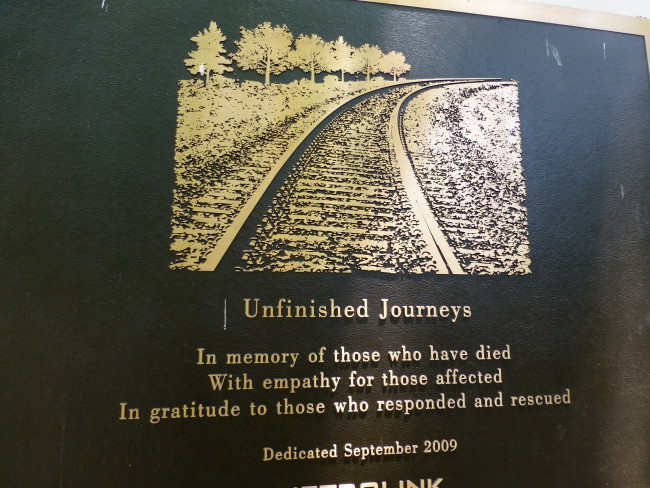 In 2008, a Metrolink commuter train collided with a Union Pacific freight train in Chatsworth, killing 25 people and injuring more than 130 others. This plaque honors those that have lost their lives in train accidents, others who were injured and also their rescuers. It was placed at Union Station in September 2009, one year after the Chatsworth crash.
In 2008, a Metrolink commuter train collided with a Union Pacific freight train in Chatsworth, killing 25 people and injuring more than 130 others. This plaque honors those that have lost their lives in train accidents, others who were injured and also their rescuers. It was placed at Union Station in September 2009, one year after the Chatsworth crash.
Tracy and I also have many other unfinished journeys to go on, and I hope you travel with us on many of them.
(FYI, after you are done with the tour, walk a short distance across Alameda Street to Philippe The Original for a French Dip sandwich. For more on this historic restaurant, click on Tom’s Dining Out and scroll down to Philippe The Original to learn more about it)
Los Angeles Union Station
800 North Alameda Street
Los Angeles Union Station
Los Angeles, CA 90012
Los Angeles Conservancy Union Station Walking Tour
Every Saturday starting at 10 a.m.
Cost $10 (members of the Conservancy and kids under 12 – $5)
No walk-ins (since the 75th anniversary, these tours often sell out early)
Phone: 213.623.2489 (Monday – Friday 9 a.m. – 5 p.m.)
www.laconservancy.org
How to Get To Union Station:
By Rail: Take Metrorail. The tour starts at Union Station. From the train platform make your way to the Union Station terminal. The tour begins in the Entrance Lobby.
By Car: Parking ($6.00/day) is available at Union Station. Follow signs to the Vignes Street parking garage accessible from Vignes Street, directly behind the railroad station. Alternatively, parking is available on Main Street, near Olvera Street.

